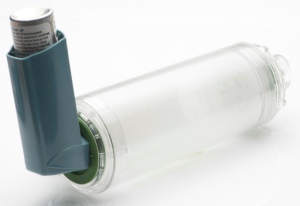Spacers and Valved Holding Chambers (VHCs) for Use with Metered Dose Inhalers (MDIs)
 Spacers and Valved Holding Chambers (VHCs) are medical devices approved by the Food and Drug Administration for use with inhaled medications. These may be prescribed as recognized medical devices. The purpose of using a spacer/VHC is to improve inhaled medication delivery to the lower airways and decrease potential side effects such as candidiasis (thrush) and dysphonia (hoarseness). This is achieved primarily by enhancing hand-mouth coordination with the use of metered-dose inhalers (MDI) which reduces oral deposition of the particles and increases the fraction of droplets.
Spacers and Valved Holding Chambers (VHCs) are medical devices approved by the Food and Drug Administration for use with inhaled medications. These may be prescribed as recognized medical devices. The purpose of using a spacer/VHC is to improve inhaled medication delivery to the lower airways and decrease potential side effects such as candidiasis (thrush) and dysphonia (hoarseness). This is achieved primarily by enhancing hand-mouth coordination with the use of metered-dose inhalers (MDI) which reduces oral deposition of the particles and increases the fraction of droplets.
Spacer is a generic term for any open tube placed on the mouthpiece of an MDI to extend its distance from the mouth. A VHC is a spacer that is manufactured with a one-way valve to regulate inspiratory flow and prevent exhalation into the device. Often, a VHC has a whistle to provide feedback on correct inspiratory flow. Due to its one-way valve and whistle, VHCs are preferable to spacers.
The speed of inspiration is important. If inhaled medication such as corticosteroids are inhaled too slowly, the medicine can remain in the mouth leading to increased risk of candidiasis. If the medication is inhaled too quickly, the medicine can be deposited in the back of the throat leading to increased risk for dysphonia (hoarseness).
Spacers/VHCs are made of either polycarbonate plastics or metal. Typically they are shaped like a tube with openings at both ends; one opening is the mouthpiece that is placed into the mouth and the other opening is where the MDI is inserted. Infants, young children and adults with disabilities can use MDIs when the VHC is fitted with a facemask. If a facemask is used, it must be fitted to create a tight seal and reduce the volume of dead space (important for reducing drug-loss).
Correct Use of the MDI with Spacer/VHC
1. Inspect the mouthpiece to make certain there are no foreign objects that might be inhaled.
2. Remove the cap of the MDI, shake the MDI and insert the MDI into the non-mouthpiece opening.
3. Activate the inhaler ONE time immediately after the start of a slow deep breath and continue to inhale in for 3-5 seconds. If you hear the whistle, reduce the rate of inspiratory flow until the whistle disappears; this is the correct inspiratory flow.
4. Hold the breath for 10 seconds or as long as comfortably possible.
5. Repeat as prescribed.
NOTE: If a facemask is being used with a child or adult who cannot actively participate in medication-taking, hold the VHC with facemask in place for 6 full breaths. This equals one puff. Repeat as prescribed.
Care and Cleaning
Manufacturers’ recommendations for care and cleaning will differ by the frequency of use, the type of device and whether the spacer/VHC is made of plastic or a non-static plastic or metal. The directions below are general guides. Please refer to the manufacturers’ instructions to determine the correct care for a specific device.
Spacers/VHCs NOT Made of Anti-Static Plastics or Metals
1. Disassemble all removable parts.
2. Wash by hand and soak in diluted household detergent for 15 minutes. Agitate gently.
3. Do NOT rinse. Do not use bottle washers.
4. Allow to dry thoroughly in a vertical positon.
5. Reassemble and use as directed.
Spacers/VHCs Made of Anti-Static Plastic or Metals
1. Disassemble all removable parts.
2. Wash by hand and soak in diluted household detergent for 15 minutes. Agitate gently. If dishwasher safe, place on the top rack of the dishwasher. Do not use bottle washers.
3. Allow to dry thoroughly in a vertical positon.
4. Reassemble and use as directed.
Learn more about Asthma.
10/31/2023